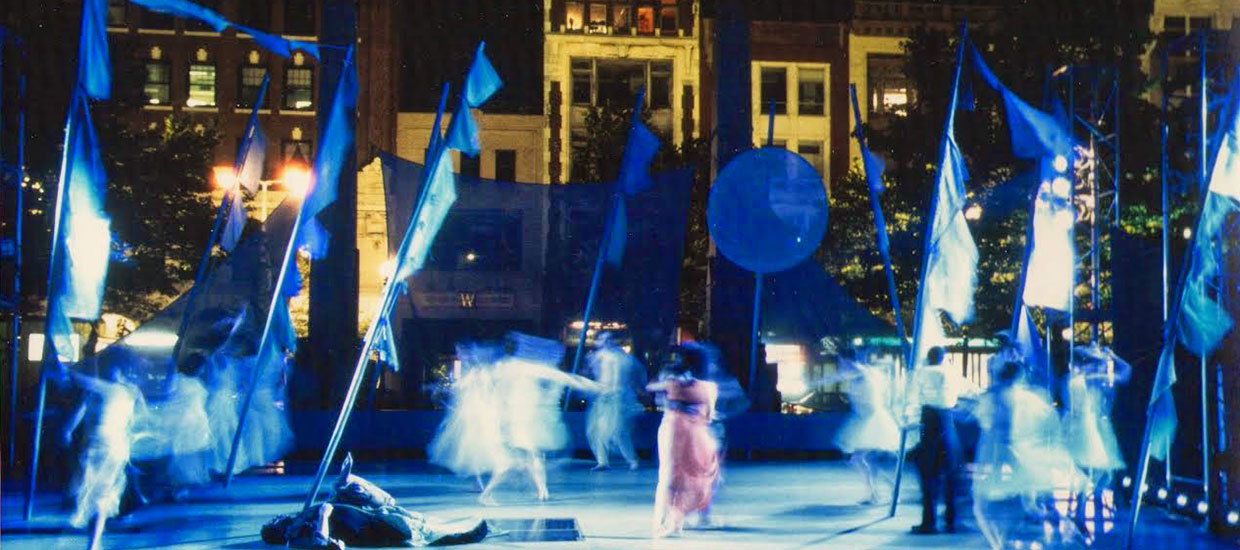A mid-city ‘Dream’ comes true
The Boston Globe
by: Ed Siegel
Jul 22, 1996
A MIDSUMMER NIGHT’S DREAM Play in five acts by William Shakespeare Directed by Steven Maler. Set, Susan Zeeman Rogers. Costumes, Jane Alois Stein. Lighting, John Malinowski. Choreography, Amy Spencer and Richard Colton. Music and sound, Christopher Walker. Produced by the Commonwealth Shakespeare Company in association with Arts Boston at: Copley Square Saturday night
Anyone who believes in the transformational power of art in general and theater in particular had to be overjoyed with what happened in Copley Square this weekend. And any of the many artistic, political and corporate groups that made “A Midsummer Night’s Dream” a midsummer week’s reality have to be ecstatic with what the Commonwealth Shakespeare Company pulled off despite a Friday night rainout and a Saturday night breeze that threatened to play havoc with the sound system.
Made up mostly of American Repertory Theatre Institute alumni and students, with some help from the mother ship, the Commonwealth Shakespeare Company is all of 4 months old, and the actors look more like the cast of “Rent” than members of a Shakespeare company. That’s one of the main reasons the production was as good as it was gratifying. The nontraditional casting represents multiculturalism at its best. A Pakistani Oberon and an African-American Titania were evidence that color-blindness was possible in the forest near Athens while one of the most diverse crowds I’ve seen anywhere in Boston showed that the same was possible even here.
That wouldn’t be anything to celebrate if the production weren’t anything to speak about. While this “Dream” may have been broader than it was deep and the young actors weren’t fully at home with Shakespearean cadences, it was fully engaging and entertaining.
Chief among its virtues was its pure physicality. Whatever rhythm was lacking in speech was more than made up for in movement. Faran Tahir’s Oberon and Siobhan Brown’s Titania were forces of nature — vengeful, sensual, and mischievous. Most actresses look somewhat embarrassed being seduced by a donkey. Brown made her lust for Bottom, who had been transformed into the beast, look as natural as if he had been named People magazine’s sexiest man alive.
Transformations are what “A Midsummer Night’s Dream” is about. Men become donkeys. Lovers become haters. Fighters become lovers. Ego is transformed by id. And the characters return to Athens fuller human beings.
Tahir and Brown — who also play the Duke of Athens and his betrothed — provide most of the requisite magic and Kwana A. L. Martinez as Helena is the most enjoyable to watch of the transformed lovers. John Malinowski, whose lights do wonders for “Jackie” at the Wilbur, does as much for Shakespeare; and Susan Zeeman Rogers’ spare but effective blue-bannered set, Jane Alois Stein’s sexy costumes and Christopher Walker’s world-music sound all build a unified forest between Trinity Church and the Hancock on one side and the Boston Public Library and Prudential on the other. The production was as much a blend of the classical and the contemporary as the buildings.
Director Steven Maler fashioned the production (and the company) but give credit as well to choreographers Amy Spencer and Richard Colton, who’ve choreographed several ART productions and have their own company of dance theater. This “Dream” was a joy of movement. It’s more than the characters who are transformed in any successful “Midsummer Night’s Dream.” This production had the crowd with it from the first appearance of the comical acting company, headed by Jeremy Geidt’s Quince and Ed Yopchik’s Bottom, to the final curtain call and standing ovation. Watching a young audience respond so eagerly to Shakespeare should be proof enough of the wisdom and non-elitism of spending public money on the arts. The audience, too, returns to “Athens” fuller people.
There’s one more transformation worth talking about. The city takes on a different glow after an event like this, partly from the communality of sharing a work of art with 1,000 or so other people, partly from the pride of living in a city that finally got the wherewithal to put it together. And the city physically seems different — there’s an air of mystery and romance, a sense that more things are possible here, a pride of place that makes you look at everything from the architecture to the people in the street with a more appreciative, less jaundiced eye. Of all the transformations in this “Midsummer Night’s Dream” that’s the most important.
You usually have to be an institution — whether the ART, the BPL or the NBA — to be referred to by your initials. So with the same spirit of optimism that guided this production, let’s wish expanded fortune and long life to the CSC.



























